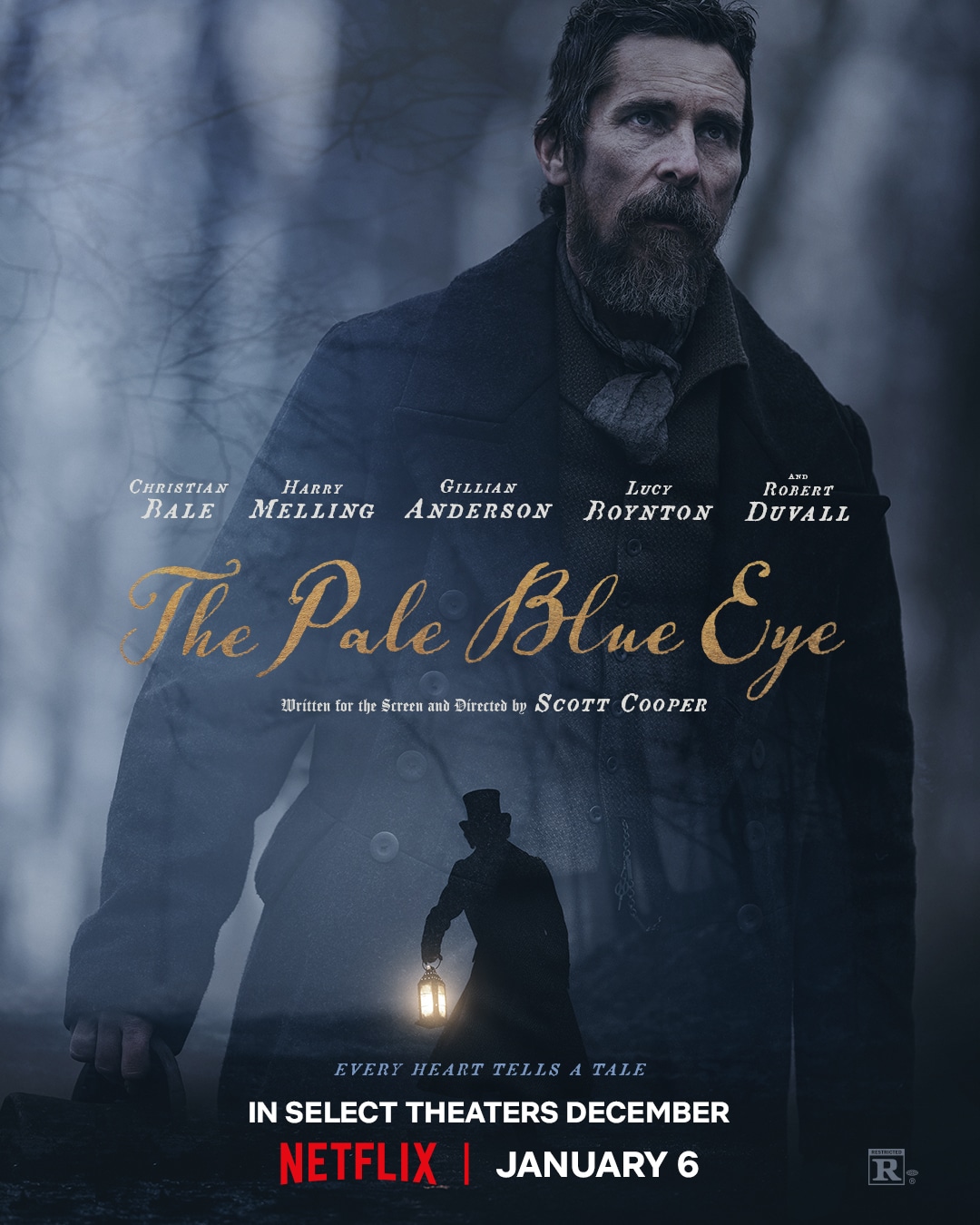
- Starring
- Christian Bale, Harry Melling, Toby Jones
- Writer
- Scott Cooper
- Director
- Scott Cooper
- Rating
- 14A (Canada), R (United States)
- Running Time
- 128 minutes
- Release Date
- January 6th, 2023 (Netflix)
Overall Score
Rating Summary
Period murder mysteries seemingly harken back to the books many of us have read and maybe that their appeal after all these years even though they are not made nearly as often as they used to be. Nevertheless, Netflix enters the fold with The Pale Blue Eye, a period murder mystery with a gothic twist that definitely feels like a slow burn mystery novel for better or worse. Therefore regardless of what else it does right technically, it will just be too slow for some audiences and will more than likely lose them. That being said, the eerie atmosphere it creates thanks to a great score and sound design underscores the mystery beautifully as it keeps audiences on their toes throughout. Meanwhile, Christian Bale shines as a flawed and grizzled detective and his fun dynamic with Harry Melling as a young Edgar Allan Poe carry the film across its many twists and turns. An issue that may arise for some audiences is the casting of several prominent British actors as post revolutionary Americans which resulted in a tightrope of accents to contend with. Some admittedly fared better than others but for the most part, did not pose too much of a distraction.
Based on a book of the same name by Louis Bayard, The Pale Blue Eye takes place in 1830s upstate New York where a suspicious death of a cadet at the West Point military academy. In order to try to protect the reputation of the academy, its top brass enlisted the help of an experienced local detective named Augustus Landor (Bale), to solve the murder. However, as an outsider, breaking through proved to be a challenge as far as his investigation was concerned. In order to get anywhere, he would have to penetrate what appeared to be a code of silence among the academy’s cadets. Lander’s only hope was an eccentric and overzealous cadet named Edgar Allan Poe (Melling), who would turn out as THAT Edgar Allan Poe. Fascinated with poetry and other literary works than the military, he was indifferent to that life which made him an outsider in the eyes of his fellow cadets. The reason he was there in the first place was unclear but one could only think that it became an inspiration for his later works as the story implied it to be the case. It may seem like an Edgar Allan Poe origin story without ever quite getting there. While Landor had the means to solve the case through his intelligence, resources, and experience, Poe provided some much needed perspective for the lone wolf detective.
As the situation got worse and more bodies were found, pressure was being put on Landor to solve a case that proved increasingly difficult to solve with the passage of time and no concrete suspects or evidence. As he dove deeper into the life of the first dead cadet, he made some progress as the truth behind his death went much deeper than it seemed with an added supernatural angle to possibly contend with but despite this, there was still the issue of bureaucracy to contend with. In the end, it wasn’t nearly enough to stop him and Poe but even then, things were not always what they seemed. As the truth finally all trickled up to the surface, the tension ratcheted up as the story got wild. If anything that intensity could have been ratcheted up sooner rather than the film’s slow buildup to the reveal and tipping point leading to the climax as the film merely sweeps it away as quickly as it appeared. Ultimately, as mentioned, there was more to the story as the film had a few tricks up its sleeve. However, this last turn of events did not quite feel earned and came off as tact on.
While the story may be a point of contention for some, they cannot argue the film’s technical prowess. Beyond a great score and eerie sound design, beautiful cinematography along with strong production and costume design set the stage nicely. Perhaps the fact that it takes place more outside than inside does stand out but the latter wasn’t as important as it captures the bleakness of the film’s wintery settings through a series of stunning vistas. It favored a character-centric approach for its story which would not have worked if not for its performances. The accents were a challenge for some but it did not take away from what was an impressive cast, led by the aforementioned Bale and Melling who were the best part of the film. Bale was compelling to watch as the charming yet flawed Landor who embraced the challenge of the mystery guided by a level of darkness that lied just below the surface. He fits right into this world. Reigning in Melling and his energy as the overzealous Poe made for a fun dynamic. Though the latter may bring too much to the film at times, the pairing works.
At the end of the day, The Pale Blue Eye won’t be for everyone but for fans of gothic or period murder mysteries, it delivers a more than solid watch.
still courtesy of Netflix
If you liked this, please read our other reviews here and don’t forget to follow us on Twitter or Instagram or like us on Facebook.

The EIC of the coincidentally-named keithlovesmovies.com. A Canadian who prefers to get out of the cold and into the warmth of a movie theatre.
Discover more from
Subscribe to get the latest posts sent to your email.
